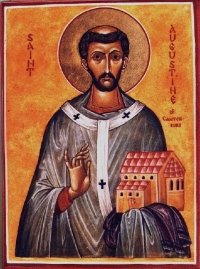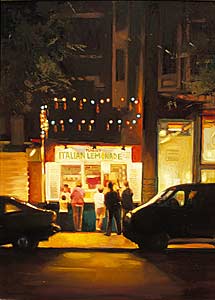Ron Howard's film adaptation of
The Da Vinci Code opens worldwide today. The controversy surrounding the film and the Dan Brown novel on which it is based almost guarantee that the film will be a blockbuster, and in common with many blockbusters
The Da Vinci Code has already been panned by critics. Like many other Catholics, I've been chagrined by the credulous response that
The Da Vinci Code's risible speculations have received in the media and on the part of many readers, but I'm content to leave the task of refutation to
the pros. I confess that I haven't read Dan Brown's book - I generally don't go for pulp potboilers - and up to now I haven't had much interest in seeing the movie either. However, if reviews like
the one A. O. Scott penned for yesterday's New York Times are any indication,
The Da Vinci Code may be one of the most unintentionally humorous films of the year - provided, of course, that you accept that its premise is bunk.
At the start of his review, Scott admits he "lack[s] the learning" to discuss
The Da Vinci Code's theology, which gives him the freedom to devote the rest of his review to the many quirks of "one of the few screen versions of a book that may take longer to watch than to read." Though Scott is no theologian, he knows enough to inform us that the albino monk (sic) Silas (played by Paul Bettany) "may be the first character in the history of motion pictures to speak Latin into a cellphone." The ubiquitous Jean Reno offers a "very grouchy" characterization of French policeman Bezu Fache - perhaps because Reno is sick of being typecast as a cop. Here's what Scott has to say about the performances given by the two leads, Tom Hanks and Audrey Tautou:
Through [the film] Mr. Hanks and Ms. Tautou stand around looking puzzled, leaving their reservoirs of charm scrupulously untapped. Mr. Hanks twists his mouth in what appears to be an expression of professorial skepticism and otherwise coasts on his easy, subdued geniality. Ms. Tautou, determined to ensure that her name will never again come up in an Internet search for the word "gamine," affects a look of worried fatigue.
While I can't judge Ms. Tautou's performance without having seen it, I wonder whether there's a smile hidden behind that "look of worried fatigue." An actress who has proven her versatility by playing both an enigmatic French gamine (
Amélie) and a weary Turkish refugee (
Dirty Pretty Things), Tautou is generally selective about the roles she accepts but
once admitted, "I wouldn't mind being in an American film for a laugh, but I certainly don't want to be in 'Thingy Blah Blah 3,' if you know what I mean." If Tautou chose to appear in
The Da Vinci Code to get a few laughs, she'd be in good company - Scott suggests that the august veteran Ian McKellen may have chosen to appear in the movie simply to amuse himself at everyone else's expense. Scott's comments on McKellen's turn as "wealthy and eccentric British scholar" Leigh Teabing are worth quoting at length:
Hobbling around on two canes, growling at his manservant . . . Teabing is twinkly and avuncular one moment, barking mad the next. Sir Ian, rattling on about Italian paintings and medieval statues, seems to be having the time of his life, and his high spirits serve as something of a rebuke to the filmmakers, who should be having and providing a lot more fun.
Teabing, who strolls out of English detective fiction by way of a Tintin comic, is a marvelously absurd creature, and Sir Ian, in the best tradition of British actors slumming and hamming through American movies, gives a performance in which high conviction is indistinguishable from high camp. A little more of this - a more acute sense of its own ridiculousness - would have given "The Da Vinci Code" some of the lightness of an old-fashioned, jet-setting Euro-thriller.
Scott concludes that he "can't support any calls for boycotting or protesting this busy, trivial, inoffensive film. Which is not to say I'm recommending you go see it." On principle I can't agree with Scott on the "inoffensive" part of his evaluation, but if
The Da Vinci Code is as bad as he says I wonder how any fair-minded viewer could take it seriously. Then again, not all viewers are fair-minded, nor are most likely to have the time or interest to read the many books and articles that have been published to refute
The Da Vinci Code's far-fetched contentions. However, when one considers the many challenges that the Church has overcome in the past, the hoopla over
The Da Vinci Code seems pretty insignificant. A generation from now, will anyone remember Dan Brown's book or the film on which it is based? My guess is that no one will, outside of a small circle of trivia buffs.
Sic transit gloria mundi. AMDG.






